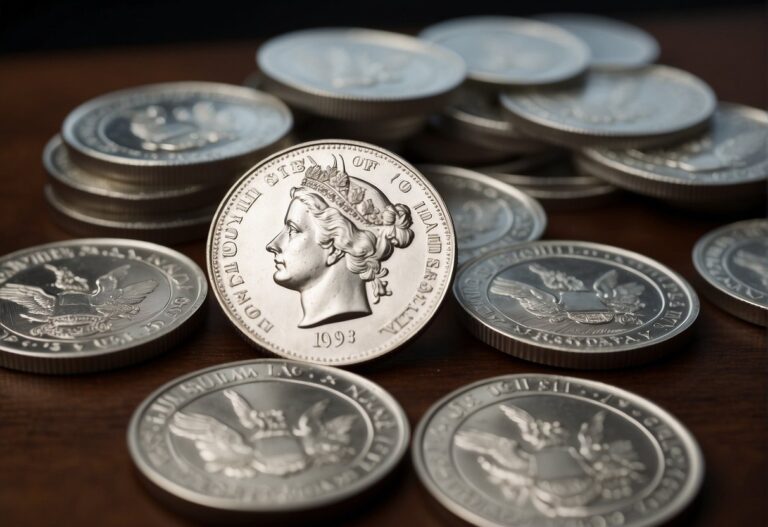Essential Insights For Gold IRA Investing
- Investors can include physical gold, such as coins or bullion, in their Gold Individual Retirement Accounts (IRAs).
- These specialized IRAs can be funded with either pre-tax or post-tax dollars and require setting up through an authorized custodian or broker.
- The Internal Revenue Service (IRS) allows IRAs to contain certain metals like gold, silver, platinum, or palladium in accepted forms.
- Maintaining a Gold IRA typically involves higher costs than standard IRAs due to the necessity of securely storing physical assets.
- Contribution limits to Gold IRAs are determined annually by the IRS and are in line with traditional retirement account contributions.
Understanding How To Invest In Gold IRAs
A Gold Individual Retirement Account (IRA) is a specialized retirement savings account that allows individuals to invest in precious metals like gold, silver, platinum, and palladium instead of traditional stock market assets. Different from standard IRAs, Gold IRAs require the purchase of physical metals, which means these assets can include gold bullion, coins, or bars, among other forms.
These accounts are typically self-directed, providing a broader investment selection than other IRAs. Because of the assets involved, a custodian, such as a bank or brokerage, must handle the account. The IRS approves certain forms of metal, including bullion and coins, provided they meet purity and fineness standards.
Beyond physical gold bullion and metal, Gold IRAs may also encompass gold-related paper assets, including:
- Exchange-traded funds (ETFs) with a focus on gold
- Shares in gold mining companies
- Precious metals mutual funds
- Commodity futures related to precious metals
To establish a Gold IRA, one can use either pretax income, as with a traditional IRA, or post-tax income, as with a Roth IRA. However, an important consideration is that due to the requirements of purchasing and safely storing physical metal, the costs associated with these accounts can be higher, reflecting fees for both acquisition and custodianship.
The appeal of a Gold IRA lies in the durable nature of gold investments and the potential for these types of assets to hedge against inflation or market volatility. However, all investments come with inherent risks, including fluctuating gold prices.

How To Establish a Precious Metals IRA
Establishing a Gold Individual Retirement Account (IRA) requires partnering with a specialized custodian or firm adept at handling complex regulations, documentation, and tax reporting specific to these accounts. Unlike conventional retirement accounts managed by typical brokerage firms, a Gold IRA demands a trustee who understands the intricacies of investing in precious metals.
Key Steps to Set Up a Gold IRA:
- Choosing a Trustworthy Custodian: Seek out the best gold IRA companies known for their expertise and ability to guide you through the process.
- Funding Your Account: You must adhere to the IRS’s annual contribution limits, which for 2023 are $6,500 or $7,500 if you’re 50 years or older. The limits increase in 2024 to $7,000 and $8,000 respectively.
- Understanding Distribution Rules: Withdrawals can be penalty-free after 59½ years. Early distributions attract a 10% additional tax.
Storage Requirements for Gold IRAs:
- Choosing an IRS-Approved Depository: Your gold assets should be stored at a secure facility sanctioned by the IRS, including certain banks or depositories.
- Prohibition of Home Storage: Holding precious metals at home is considered a withdrawal and will incur taxes; your assets must be in the custody of approved entities such as American Bullion or JM Bullion.
By investing in a Gold IRA, individuals can leverage gold’s potential as an inflationary hedge and enhance the diversity of their retirement portfolio. Custodians such as Goldco and other acclaimed precious metals dealers offer valuable guidance, ensuring compliance with regulations and facilitating a smooth investment journey.

Diverse Options for Gold IRA Retirement Accounts
Gold-based Individual Retirement Accounts (IRAs) offer investors different structures to accommodate various tax preferences and financial strategies:
- Pre-Tax Gold IRAs: Comparable to traditional IRAs, these accounts utilize pre-tax dollars. One can expect the funds and gains to accumulate without immediate taxation, deferring tax liability until funds are withdrawn during retirement.
- Post-Tax Gold IRAs: Similar to Roth IRAs, contributions are made with post-tax funds. While this does not furnish an upfront tax benefit, distributions taken upon retirement are tax-free.
- Simplified Employee Pension (SEP) Gold IRAs: Designed for small business employees or the self-employed, SEP Gold IRAs function like their traditional counterparts. Contributions come from pre-tax income and are tax-deductible, with taxes applied only upon withdrawal in retirement.
- Contribution limits are subject to regulation, with the Internal Revenue Service setting caps at 25% of income or $66,000 for 2023 ($69,000 for 2024), whichever is the lower amount.
These IRAs incorporate gold and can involve other precious metals, diversifying one’s retirement portfolio. Selecting the most appropriate Gold IRA depends on individual financial circumstances and retirement goals.
Considerations Before Investing In A Gold IRA
Investing in a Gold Individual Retirement Account (IRA) carries certain risks and costs that investors should weigh carefully. Unlike equities, gold does not generate dividends, and because it is a tangible asset, it necessitates secure storage. Individuals may confront several fees, such as:
- Setup and Administrative Fees: These can vary significantly among providers, and initial setup fees can sometimes be high.
- Storage Fees: Secure storage is necessary for physical gold, leading to recurring costs for safeguarding your investment.
Furthermore, buying and selling within this type of IRA isn’t free of additional expenses:
- Commissions and Markups: Dealers often charge premiums above the gold market price, which can reduce potential returns.
- High Brokerage Fees: Some accounts might have higher brokerage fees when compared to more conventional IRAs.
When considering liquidation:
- Selling Costs and Penalties: Accessing funds before retirement can lead to significant penalties and taxes.
- Required Minimum Distributions (RMDs): Although gold is touted for its stability, it can be challenging to offload precise amounts for RMDs without selling a more significant portion than necessary.
The performance of gold can be volatile despite its reputation as a safe investment during economic uncertainty. While gold prices can surge in times of financial crisis, such as its peak during the 2008 financial crisis and the 2020 coronavirus pandemic, they can as quickly fall when the economy recovers.
Additionally, gold does not benefit from compound growth like stock market investments, which have historically outperformed gold over extended periods:
- Performance Comparison: For nearly three decades, from the 1980s to 2006, the broader stock market delivered significant returns, whereas gold prices largely stagnated.
Investors should consider that while precious metals can form part of a diversified investment portfolio, historical trends suggest that the returns may sometimes parallel those from broader economic markets.

Evaluating the Merits of Gold IRAs
When considering Gold IRAs for retirement, investors often weigh their diversification benefits and potential as an inflation hedge. They can add value to a retirement portfolio like stocks, bonds, or mutual funds. However, financial experts usually advise allocating only a modest amount of one’s retirement assets to alternative investments to manage risk tolerance effectively.
Annual Limits for Gold IRA Contributions
For 2024, Gold IRAs—whether Traditional or Roth—have a $7,000 annual contribution limit. Individuals 50 or older can add an extra $1,000, raising their limit to $8,000. These limitations align with standard Individual Retirement Account rules.
Eligibility of Gold in IRA Portfolios
- Gold must conform to IRS purity standards.
- A licensed trustee is mandated to hold the gold.
- Storage must be in an IRS-sanctioned depository.
- IRA account regulations forbid the IRA owner from keeping the gold.
Essential Insights on Gold Individual Retirement Accounts
Transparency about its operations and regulations is paramount in examining a Gold Individual Retirement Account (IRA). These accounts offer the unique benefit of incorporating precious metals, like gold, into one’s retirement savings, safeguarding against inflation and economic instability.
- Tax Advantages: Similar to traditional IRAs with the unique capability to hold metals.
- Physical Assets: Includes gold, silver, platinum, and palladium.
- Rules: Adherence to specific regulations is required.
- Consultation Recommended: Seek advice from a financial advisor.
For those interested:
- Frequently Asked Questions: Provides clarity on function and benefits.
- Track Record: Reflects a history of performance during market fluctuations.
- BBB Rating: Assists in evaluating the credibility and reliability of financial advisors.
Common Inquiries About Precious Metal IRAs
Steps to Establishing a Metal-based Gold IRA Retirement Account
To open a precious metals IRA, one must:
- Choose a self-directed IRA custodian.
- Complete the necessary paperwork to establish an account.
- Fund the IRA through a transfer, rollover, or cash contribution.
- Select the specific metals to include in the IRA, ensuring they meet purity standards.
- Purchase the metals through a dealer and store them in an IRS-approved depository.
Pros and Cons of a Gold-Backed Retirement Account
When considering a gold IRA, one should weigh:
- Advantages:
- Diversification from market volatility.
- Potential hedge against inflation.
- Gold maintains intrinsic value.
- Disadvantages:
- Storage fees and insurance costs.
- Less liquidity compared to traditional assets.
- Potential for market fluctuations affecting gold prices.
Varieties of IRAs for Precious Metal Investments
Precious metals IRAs come in different forms:
- Traditional IRA: Pre-tax dollars, taxed at withdrawal.
- Roth IRA: After-tax dollars, tax-free growth and withdrawal.
- SEP IRA: For self-employed or small business owners with higher contribution limits.
- SIMPLE IRA: Similar to SEP, but for smaller companies and includes employee contributions.
Initial Investment Requirements for a Gold IRA
The minimum investment threshold for a gold IRA varies by provider but typically starts around $5,000 to $10,000.

Comparing Gold IRAs to Direct Physical Gold Ownership
Owning gold via an IRA versus physical possession:
- Gold IRAs: Offers tax advantages, requires custodian management, and incurs storage costs.
- Physical Gold: Provides direct control and access, no annual fees, but lacks tax benefits.
Tax Considerations for Gold IRA Investors
Investing in a Gold IRA involves:
- Contributions are made with pre-tax (Traditional) or post-tax (Roth) dollars.
- Taxes apply on distributions from a Traditional IRA.
- Roth IRAs offer tax-free withdrawals under qualifying conditions.
- IRS enforces specific reporting for transactions and valuations.



